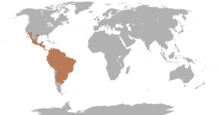| Peccaries Temporal range:
| |
|---|---|

| |
| Collared peccary, Dicotyles tajacu | |
| Scientific classification | |
| Domain: | Eukaryota |
| Kingdom: | Animalia |
| Phylum: | Chordata |
| Class: | Mammalia |
| Order: | Artiodactyla |
| Suborder: | Suina |
| Family: | Tayassuidae Palmer, 1897 |
| Type genus | |
| Tayassu Waldheim, 1814
| |
| Extant and subfossil genera | |

| |
| Range of the peccaries | |
| Synonyms | |
|
Dicotylidae | |
Peccaries (also javelinas or skunk pigs) are pig-like ungulates of the family Tayassuidae (New World pigs). They are found throughout Central and South America, Trinidad in the Caribbean, and in the southwestern area of North America. Peccaries usually measure between 90 and 130 cm (2 ft 11 in and 4 ft 3 in) in length, and a full-grown adult usually weighs about 20 to 40 kg (44 to 88 lb). They represent the closest relatives of the family Suidae, which contains pigs and relatives. Together Tayassuidae and Suidae are grouped in the suborder Suina within the order Artiodactyla (even-toed ungulates).
Peccaries are social creatures that live in herds. They are omnivores and eat roots, grubs, and a variety of other foods. They can identify each other by their strong odors. A group of peccaries that travel and live together is called a squadron. A squadron of peccaries averages between six and nine members.[1]
Peccaries first appeared in North America during the Miocene and migrated into South America during the Pliocene–Pleistocene as part of the Great American Interchange.
They are often confused[2] with feral domestic pigs, commonly known as "razorback" hogs in many parts of the United States,[3] when the two occur in the wild in similar ranges.
The Maya kept herds of peccaries, using them in rituals and for food.[4] They are kept as pets in many countries in addition to being raised on farms as a source of food.[5]
- ^ Organ Pipe Cactus National Monument, Arizona - informational web site at https://www.nps.gov/opi/learn/nature/javelina.htm
- ^ Miller, George Oxford (October 1988). "The Javelina - Prickly Pear Gourmand". A Field Guide to Wildlife in Texas and the Southwest. Texas Monthly Press. pp. 61–64. ISBN 978-0-87719-126-1.
many people confuse them with domestic pigs gone wild
- ^ Susan L. Woodward; Joyce A. Quinn (2011). Encyclopedia of Invasive Species: From Africanized Honey Bees to Zebra Mussels. ABC-CLIO. p. 277. ISBN 978-0-313-38220-8.
- ^ Dillon, Brian B. (1988). "Meatless Maya? Ethnoarchaeological Implications for Ancient Subsistence". Journal of New World Archeology. 7: 60.
- ^ "Commercial farming of collared peccary: A Large-scale commercial farming of collared peccary (Tayassu tajacu) in North-Eastern Brazil". Pigtrop.cirad.fr (2007-04-30). Retrieved on 2012-12-18.